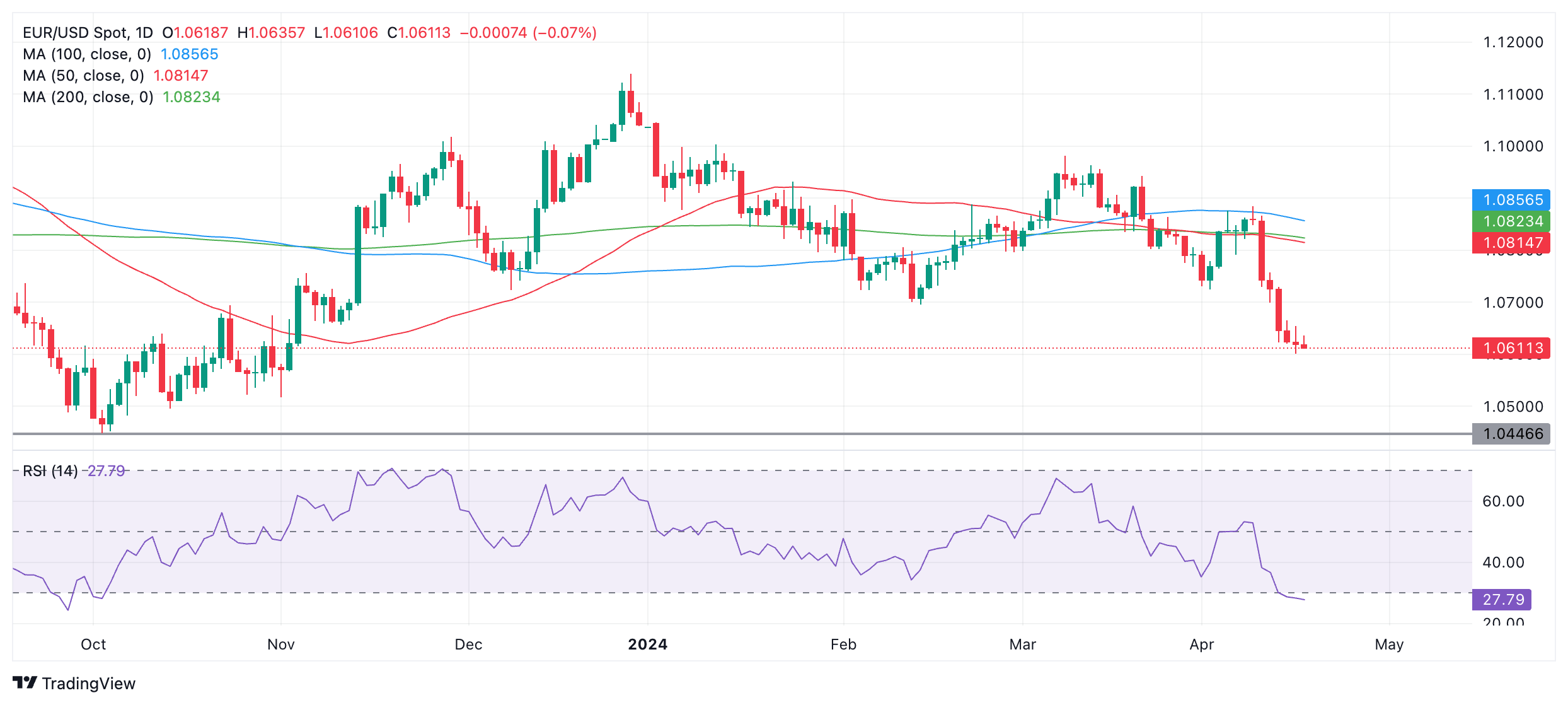- EUR/USD recovers after the release of HICP inflation data for the Eurozone.
- Speeches by several key ECB governing council members could also impact EUR/USD.
- EUR/USD enters oversold levels on the daily chart, indicating risk of a pullback.
EUR/USD rebounds by about two-tenths of a percentage point into the mid 1.0600s on Wednesday after the release of the final estimates for Eurozone March Inflation data.
EUR/USD: recovers after final estimates, ECB speeches
EUR/USD saw a lift on Wednesday after the final reading of the Harmonized Index of Consumer Prices (HICP) came out in line with the iinitial estimates at 2.4% year-on-year. This was down from 2.6% YoY in February.
The Core HICP showed a 2.9% rise YoY also in line with flash estimates, from 3.1% in February. Month-on-month readings were also in line with initial estimates.
The lack of change in the final estimate may have taken the heat out of increasingly dovish expectations regarding interest rates. A rate cut in June is now widely expected, and since lower interest rates, or their expectation, tend to reduce foreign capital inflows, this has been depreciating the Euro (EUR) and pushing down EUR/USD.
Speeches by key ECB members throughout the day, including ECB Executive Board Member Piero Cipollone, ECB Executive Board Member Isabel Schnabel and President Christine Lagarde herself could also impact the pair’s volatility.
The case for an imminent cut in interest rates – the ECB’s key main refinancing operations rate stands at 4.50% – was strengthened on Tuesday after ECB President Christine Lagarde said that the ECB will cut rates soon, bar a surprise, and that the ECB was keeping a close eye on Oil prices due to tensions in the Middle East.
The pair has been in the oversold zone on charts, increasing the odds of an upward correction potentially evolving on the horizon.
Technical Analysis: EUR/USD bears are oversold
The EUR/USD pair is firmly in a downtrend on both its short and medium-term time frames, since peaking and rolling over at 1.1139 in December.
EUR/USD Daily Chart
The downtrend thesis is supported by the fact that the pair is trading below all its key major moving averages – the 50-day, 100-day and 200-day Simple Moving Averages (SMA).
It is making lower lows and lower highs and this trend is biased to continue – with one caveat.
The Relative Strength Index (RSI) momentum indicator is flashing oversold on the daily chart. At the moment this is only a warning for short-traders not to add to their positions, however, if the RSI were to exit oversold and rise back above 30, it would be a sign the pair was correcting and for short-traders to close their positions and open longs.
As things stand it is still possible the pair could continue lower and even if there is a correction the dominant downtrend is still likely to resume. The next key downside target for the pair is the 2023 lows at 1.0446.
If a pullback evolves, meanwhile, a possible target could be the swing low at 1.0700.
(This story was corrected on April 17 at 13:40 GMT to say that the EUR/USD saw a lift on Wednesday not Tuesday as previously written.)
Euro FAQs
The Euro is the currency for the 20 European Union countries that belong to the Eurozone. It is the second most heavily traded currency in the world behind the US Dollar. In 2022, it accounted for 31% of all foreign exchange transactions, with an average daily turnover of over $2.2 trillion a day. EUR/USD is the most heavily traded currency pair in the world, accounting for an estimated 30% off all transactions, followed by EUR/JPY (4%), EUR/GBP (3%) and EUR/AUD (2%).
The European Central Bank (ECB) in Frankfurt, Germany, is the reserve bank for the Eurozone. The ECB sets interest rates and manages monetary policy. The ECB’s primary mandate is to maintain price stability, which means either controlling inflation or stimulating growth. Its primary tool is the raising or lowering of interest rates. Relatively high interest rates – or the expectation of higher rates – will usually benefit the Euro and vice versa. The ECB Governing Council makes monetary policy decisions at meetings held eight times a year. Decisions are made by heads of the Eurozone national banks and six permanent members, including the President of the ECB, Christine Lagarde.
Eurozone inflation data, measured by the Harmonized Index of Consumer Prices (HICP), is an important econometric for the Euro. If inflation rises more than expected, especially if above the ECB’s 2% target, it obliges the ECB to raise interest rates to bring it back under control. Relatively high interest rates compared to its counterparts will usually benefit the Euro, as it makes the region more attractive as a place for global investors to park their money.
Data releases gauge the health of the economy and can impact on the Euro. Indicators such as GDP, Manufacturing and Services PMIs, employment, and consumer sentiment surveys can all influence the direction of the single currency. A strong economy is good for the Euro. Not only does it attract more foreign investment but it may encourage the ECB to put up interest rates, which will directly strengthen the Euro. Otherwise, if economic data is weak, the Euro is likely to fall. Economic data for the four largest economies in the euro area (Germany, France, Italy and Spain) are especially significant, as they account for 75% of the Eurozone’s economy.
Another significant data release for the Euro is the Trade Balance. This indicator measures the difference between what a country earns from its exports and what it spends on imports over a given period. If a country produces highly sought after exports then its currency will gain in value purely from the extra demand created from foreign buyers seeking to purchase these goods. Therefore, a positive net Trade Balance strengthens a currency and vice versa for a negative balance.

